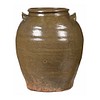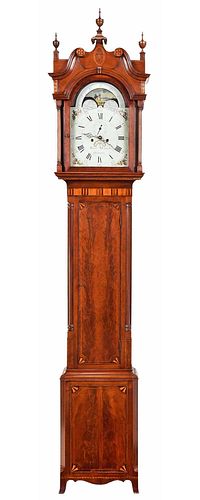Important Virginia Federal Patriotic Tall Case Clock
Bid Increments
| Price | Bid Increment |
|---|---|
| $0 | $25 |
| $100 | $50 |
| $1,000 | $100 |
| $2,000 | $200 |
| $3,000 | $250 |
| $5,000 | $500 |
| $10,000 | $1,000 |
| $20,000 | $2,000 |
| $50,000 | $5,000 |
| $100,000 | $10,000 |
dial signed "Saml Martin" and "Wheeling" for Samuel Martin (1768-1825) who worked in Wheeling Virginia (now West Virginia) between 1798-1801, the case attributed to John Brown (1761-1835) of Wellsburg and Bethany (West) Virginia, with arched painted dial with moon phase and floral spandrels, set in very fine inlaid and bookmatched veneered waisted case with line and rope inlaid inset quarter columns, highly figured cherry case, central drawer with two highly figured bookmatched veneered panels with quarter fan inlay and rope twist beading, elaborately carved and inlaid hood pagoda form central finial plinth above an eagle inlaid panel flanked by scrolled necks with inlaid rosettes, rope twist inlaid side finial plinths, urn finials, central finial with inlay, with pendulum and two weights, 105-1/2 x 20 x 10 in.
Provenance: Estate of William Gordon Buckner (1934-2016) of Marshall, Missouri. The clock descended in the Buckner family, likely from Henry Buckner (.1730, Caroline County, Virginia, d. Cocke County, Tennessee, 1815).Note:This clock is exceptional not only for the quality of the design and quantity of inlay, but also for the seminal moment that it represents in the convergence of key personalities in the cultural life of Virginia?s northwestern frontier. ÿIt has an eight-day movement by the previously unknown Virginia clockmaker Samuel Martin (1768-1825), an Ulster-Scot who hailed from Dublin, Ireland, and worked there prior to immigrating to Virginia in 1798. ÿCabinetmaker John Brown hailed from Celtic forebears who arrived in Maryland at mid-century from the Isle of Man. The pediment he created?with boldly shaped scrolls and an ambitiousÿparapetÿthat projects above them?is among the finest anywhere in that era.
The case is the most ambitious of four examples presently known from Brown?s shop, and provides a striking parallel to a closely related clock (Figure 2) with an eight day movement dated ?May 4, 1802? and signed by Hugh Andrews (1761 ? 1821) of Wellsburg, scarcely 10 miles from Wheeling.[1]ÿThe eagle medallion seen in both of the clocks embody the skill of a London-trained Baltimore artisan who sold his work to cabinetmakers as far away as western Virginia, and Kentucky.[2]
The case bears the original movement, made and signed by the Irish-born, Ulster Scot clockmaker, Samuel Martin (1768-1825). ÿIn 1795, after completing his obligation as a journeyman in Dublin, he seems to have briefly served as journeyman in that city, and by some point late in 1797, or early ?98, departed for America.[6]
As with many Ulster Scots he headed directly to the ?western frontier??in this case, Wheeling, [now West] Virginia?and onÿApril 18th, 1798,ÿannounced to the public that he had opened his doors for business. Because no newspaper existed in Wheeling at the time, Martin sent the notice to the ?Herald of Liberty?, published 30 miles to the east in flourishingÿWashington Borough, the court-house seat for Washington County, Pennsylvania.
ÿ
No other clock survives from Martin?s years in Wheeling. When he next advertised on May 5th, 1801, he had moved north and set up shop at 43 Maiden Lane, in New York City. There, in theÿAmerican Citizen, he offered clocks ?of his own manufacture,? including ?an elegant TIME PIECE, neatly finished, suitable for a Bank, Gentleman?s Hall, or any Public Office.?ÿHe ran the notice again on June 3rdand July 10th.
The clock is accompanied by a detailed writeup from Sumpter Priddy Antiques, outlining exceptional documentation and research regarding the clock's history and rarity.
Condition
Purchased items will be available for pick up or shipping from our Asheville, North Carolina auction facility within ten business days of the auction will be assessed a storage fee of $5.00 per day, per item. Purchaser agrees that packing and shipping is done at the purchaser's risk and that the purchaser will pay in advance all packing expenses, materials, carrier fees and insurance charges. At our discretion, items will either be packed by an agent such as a packaging store or Brunk Auctions. Please allow two weeks for shipping after payment is received. Shipment of large items is the responsibility of the purchaser. We are happy to provide names of carriers and shippers if a purchaser so requests. Brunk Auctions will have no liability for any loss or damage to shipped items.
































